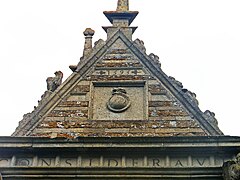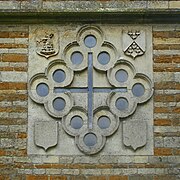Rushton Triangular Lodge
| Rushton Triangular Lodge | ||
|---|---|---|
 Rushton Triangular Lodge |
||
| Data | ||
| place | Rushton (Northamptonshire) | |
| architect | Thomas Tresham | |
| Client | Thomas Tresham | |
| Construction year | 1593 to 1597 | |
| Coordinates | 52 ° 26 '21.5 " N , 0 ° 46' 47.6" W | |
|
|
||
The Rushton Triangular Lodge is an unusual ornate structure designed by Sir Thomas Tresham and constructed on the plan of an equilateral triangle near Rushton, Northamptonshire , England between 1593 and 1597 . The building has many symbols based on the number three that are meant to remind of the Holy Trinity . The Triangular Lodge is one of four triangular buildings in England by the end of the 16th century next to Geddington Cross, the tower of Maldon Church and Longford Castle . Today it is in the care of the English cultural heritage .
background
Thomas Tresham was a wealthy member of the English elite who had inherited large estates from his grandfather and namesake Thomas Tresham I in 1559. He was the correspondent of William Cecil , Foreign Secretary of Queen Elizabeth I , and the Lord Chancellor Sir Christopher Hatton . In 1573 he was elected Sheriff of Northamptonshire and knighted on July 18, 1575 on the Queen's Royal Progress at Kenilworth Castle . There are reports that he did not convert to Catholicism until 1580, but there are many indications that he was a Catholic all his life. Although he was loyal to the Queen, he was imprisoned in Wisbech Castle and the Episcopal Palace of Ely in 1580 for his Catholic faith . Elizabeth's conflict with Pope Pius V , Mary Queen of Scots and King Philip II of Spain made Catholics the target of persecution as a potential threat to their power. He was imprisoned for a total of fifteen years for refusing to become an Anglican.
Tresham used his imprisonment as an opportunity to develop a personal mystical theology based on number symbolism . In 1593 he had a mystical experience while a servant was reading to him from a book by the English Jesuit and politician Robert Parsons .
“… It fortuned that Fulcis, my then servant, reading in the 'Christian Resolution', in the 'Treatise of Proof that there is a god'… there was upon a wainscot table at that instand, three loud knocks (as if had been with an iron hammer) given. "
“… Was lucky that Fulcis, my servant at the time, read the 'Christian Resolutions', the 'Treatise on the Proof that There is a God'… at that moment, three loud knocks rang out on a table, with one, so to speak Iron hammer. "
Tresham interpreted this as a sign from God to honor the Holy Trinity. After his release in 1593, he designed the lodge as a sign of protest and a testimony of his faith.
location
Triangular Lodge is in Rushton, Northamptonshire, in a small, tree-lined, fenced-in area on the edge of the park at Rushton Hall, where Thomas Tresham lived. The building was part of a warren , an artificial, enclosed facility for keeping rabbits, which was used to obtain meat and hide. During Tresham's lifetime the building was called Warren's Lodge . It was only given its current name after his death. The lodge is about 1 mile west of Rushton and 3 miles from Desborough on the A6 .
building
The floor plan is an equilateral triangle . The three walls are each 33.3 feet long. The building has three floors and a triangular chimney as well as three steep triangular gables, each of which is surmounted by a three-sided end at the top. Each of the walls has three rows of three windows. The half-basement windows are small battlements with triangular lights, the windows on the ground floor are in the shape of a cross with three round windows at the end of each arm that form a diamond. Each floor has three triangular rooms and a hexagonal chamber in the middle. There is a spiral staircase in one of the triangles and an open fireplace on the first floor in another triangle.
Nine angel figures under the cornice, two on each side and one on each corner, hold pipes as gargoyles that drain the rainwater from the roof. The windows on the first floor are in the shape of a shamrock, the emblem of the Tresham family.
The emblems that are carved into the gables include the symbolic seven-armed candlestick in an octagonal table and a heptagonal table with the seven eyes of God on the southeast side . The emblems symbolize God the Father . The southwest pediment shows a dove, a serpent and the hand of God touching a globe. The triangular chimney is decorated with the Christ monogram IHS , the first three letters of the name of Jesus in Greek capital letters, a lamb and a cross and a chalice.
Inscriptions and symbols
One wall is labeled with “15”, another with “93” and the last with “TT” for the year the foundation stone was laid and the owner's initials. The inscription on the front entrance reads: “Tres Testimonium Dant” (“For there are three who bear witness”). They are words from the 1st letter of John that refer to the Trinity. It is also possible to read “Tresham testifies”, since Tres was the nickname Treshams that his wife used in her letters. Also above the door is the number 5555. The digits are oddly shaped and it is speculated that they should actually mean 3333. Perhaps it is a reference to the creation of the world, since 1593 subtracted from 5555 3962 BC. BC shows a possible date of creation according to Sixtus of Siena .
Three Latin texts, each 33 letters long, run around the building on each facade. The quotes are:
- Aperiatur terra & germinet Salvatorem: " Open the earth and bring salvation." ( Isa 45.8 EU )
- Quis separabit nos a charitate Christi ?: “Who will separate us from the love of Christ?” ( Rom 8,35 EU )
- Consideravi opera tua, Domine, et expavi: "I looked at your work, O Lord, and was afraid." (Paraphrase of Hab 3,2 EU .)
The damaged inscriptions that are engraved on each pediment add up to “Respicite non mihi laboravi” , which means: “See, I did not work for myself.” In the upper room of the Triangular Lodge there are indications that the Night a mass was celebrated, such as the inscription "SSSDDS" for "Sanctus Sanctus Sanctus Dominus Deus Sabaoth" . In the Roman rite , Sanctus (Latin "holy") was a part of the Christian communion liturgy named after its first word.
See also
Web links
- Plan of Triangular Lodge, Rushton, Northamptonshire. In: historicengland.org.uk. (English).
Individual evidence
- ^ John Burke: A Genealogical and Heraldic History of the Extinct and Dormant Baronetcies of England. Franklin Classics Trade Press, 2018, ISBN 978-0344045547 , p. 532.
- ^ Andrew Eburne: The Passion of Sir Thomas Tresham: New Light on the Gardens and Lodge at Lyveden. In: Garden History. 36, 1, 2008, pp. 114-134, doi: 10.2307 / 25472397 .
- ^ Francis Young: The Bishop's Palace at Ely as a Prison for Recusants, 1577–1597. In: British Catholic History. 32, 2014, pp. 195-216, doi: 10.1017 / S0034193200032167 .
- ↑ John Taylor: A Calendar of Papers of the Tresham Family, of the Reigns of Elizabeth and James I., 1580-1605. Preserved at Rushton Hall, Northamptonshire, Taylor & Son., London, 1871.
- ↑ Sir Thomas Tresham's Triangular Lodge. In: everything2.com. January 24, 2002, accessed October 5, 2020 .
- ^ Kristen Fairey: “Tres testimonivm dant”: The Sacred Rhetoric in the Architectural Testament of Sir Thomas Tresham's Three Lodges, c. 1593-1605. In: 125th Annual Meeting American Historical Association , 2011.
- ^ A b c Cristina Monteiro: Buildings in the Landscape Rushton Triangular Lodge - Building Survey Report. In: academia.edu. May 16, 2013, accessed on October 5, 2020 (English, also as a PDF file, 3.4 MB).
- ↑ J. Krzysztof Lenartowicz: Equilateral Triangle and The Holy Trinity. In: Journal of Architecture and Urbanism. 2014, 38 (4), pp. 220-233, doi: 10.3846 / 20297955.2014.994807 .
- ↑ 1 Joh 5,7 EU
- ↑ Klaus Henseler: From the beginning and from the end of the world. (pdf; 1.3 MB) 2010, p. 26 , accessed on October 5, 2020 (reproduced on drucker-marken.de).




